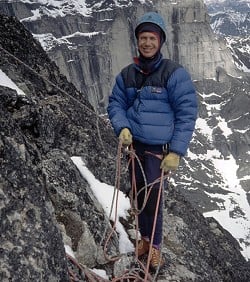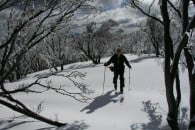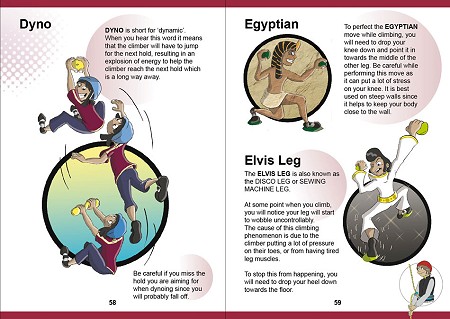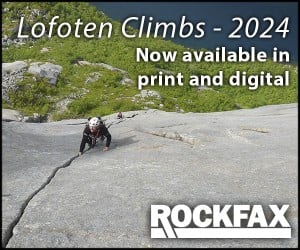

I'm always keen to check out new instructional books on climbing, both as a writer and also as an instructor. It's invariably interesting to see how much thought has gone into teaching progressions rather than simply focussing on safety points. It's relatively easy to gather the correct information; it's another matter altogether to present it in the best way for readers to learn from it. A teacher also has to decide how much to include and what should be left out. So how did this attractive new kid on the block fare?
My first impression was that this book has been built to last; a hardback cover is definitely not normal for instructional books! It looks expensive. Flicking the book over to look for the cover price I notice two things almost simultaneously – the recommended retail price of a bargain £9.95, and a unique fold-over rear cover. The inside flap ingeniously serves as a practice board for tying into a harness, with holes punched out that allow small fingers to push a mini-kernmantle through the appropriate gaps in a representation of a harness. Which brings us to an important point: this book is not aimed at adults. Or I should say, more accurately, that it's aimed at parents and other relatives to buy for children, and it fits this particular niche very well.
A parent's over-riding concerned when their loved one takes up an adventure sport is to check that the necessary safety elements are properly covered. The Beginner's Guide for Climbers handles this very well: indeed the main focus on this book is on how to climb safely: its clear from the index that the key skills covered are tying onto the rope and belaying. The final section is a pictorial vocabulary of climbing techniques: including features, techniques and calls.
So how does this book succeed in its primary aims? Very well, I think. The diagrams are delightful; the cartoon characters look confident, cool, somewhere between a waif and an urchin, with mischievous but friendly grins. They look like the sort of cool kids that would be fun to play with; role models that somehow also transcend racial stereotypes – some are clearly Caucasian but others could be of Asian or African stock: I think that most kids could identify with them.
It's clear that the author, Sophie Mitchell either has plenty of experience of working with young people, or has collaborated with people who have this background. There are loads of great ideas for how to teach kids the safety components of climbing; from putting on a harness through to taking in slack rope with a belay device – "V, down, one potato, two potato, three!" I like the detail of the flick book animation in the bottom right corner – further reinforcement of the belay technique. The pictures are clear and engaging, and there are lots of nice little visual metaphors, such as the figure of 8 shown as a racing track (to visualise re-threading) or throttling a worm to tie a figure of 8. All of the illustrations and tips are safe and correct, though I was slightly confused about the illustration on page 9 which appears to show a different and unexplained way of tying a figure of 8; however, I've replicated this method to check it and it works ok. The worm metaphor works well because you poke the little critter in the eye – this helps prevent the beginner's error of tying an overhand due to making one turn too few. If you're wondering why I'm discussing a worm's imaginary eye check the illustration above to see what I mean!
This book comes highly recommended by both NICAS (the National Indoor Climbing Achievement Scheme) and MCS (Mountaineering Council of Scotland) and I would endorse this, with minor reservations. This book will definitely help young climbers to learn the safety components of roped climbing, and it achieves this admirably. On the other hand, there's very little in here about how to actually move on rock (e.g. un-roped bouldering) and so I would describe it as an instructional book rather than a coaching resource. The final section has some great pictures of various techniques, but leaves it to the climber to work out how to actually perform most of these movements: for example we learn that "a jam is when the climber has to jam a foot or hand in to a crack". Sorted – but somehow it seems there is more to it than that? On the other hand, I'm all for breaking the mystique of jargon, which is an unnecessary block for newbies. So learning to spice your vocabulary with Gastons, Egyptians, dynos, etc. helps to break down barriers and helps motivate the next generation to learn to actually perform them as well!
This book is a delightful introduction to roped climbing, and it provides an excellent resource for teachers to help young climbers to grasp the basics and learn safe practice. It seems to me though that Sophie Mitchell has a great opportunity now to produce a book that will cover the basics of climbing movement and thus produce a coaching resource as well.
- Price: £9.95
- Free Sample: View here
- Pages: 72
- ISBN: 978 1 873341 77 3

Steve Long
Steve Long is a qualified mountain guide, works for the MLT and is an extremely experienced instructor and climber. He has produced a DVD aimed at recreational climbers - Self Rescue for Climbers - which is a comprehensive guide to solving problems encountered in such situations as multi-pitching in the mountains, sea cliffs or roadside crags.














Comments